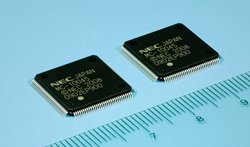
Posted on Wednesday, February 11 2009 @ 6:21 CET by Thomas De Maesschalck
NEC announced
it has developed a system-on-a-chip (SoC) that integrates all functionalities needed for DVD reading and writing on a single chip. The SoC is named SCOMBO 8 and enables manufacturers to build DVD burners with 20 percent less components and a 50 percent lower power consumption during 8x DVD burning. Mass production of the chip will commence next month.
NEC Electronics Corporation today announced that it has developed a System-on-a-Chip (SoC) product integrating all the functionalities needed for DVD writing and reading on a single chip. The new product named SCOMBO® 8 is a SoC for supporting DVD Drives equipped in PCs and home write/read appliances and has following features: (1) Integrates DVD drive control logic, synchronous DRAM, and flash memory all in a compact 14mm square flat package; (2) Delivers industry's fastest 24x DVD writing; (3) Lowers power consumption during DVD writing at 8x speed to 0.8W, reducing by 50 percent compared to the previous products.
The new product allows DVD drive manufacturers to reduce external components by 20 to 30 percent and facilitates low-cost system development with less than 100 materials. The market for CD-ROM, DVD, Blu-ray, and other optical disc drives for PCs is estimated at about 300 million per year. DVD drives account for about 80 percent of this market, with steady growth expected in the years ahead.
NEC Electronics launched a SoC with built-in DVD reading and CD write/read functionality for PC optical disc drives. Since then, the company has continuously worked to expand its product lineup, selling a cumulative 180 million products in the SCOMBO series by December 2008.
Optical disc drives in the PC market can be divided into two types, according to the height of the drive case: half-height drives or slim drives. In half-height drives, users expect higher writing speeds, while in slim drives they expect lower power consumption. In addition, users of both types seek to cut their bill of materials costs by reducing the number of components on system boards.
The new product meets all of these requirements by delivering integrated functionality, higher writing speeds, and lower power consumption.
